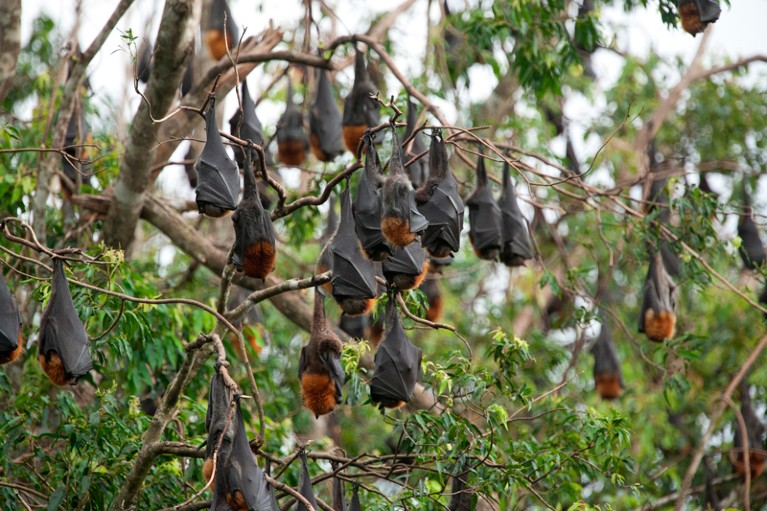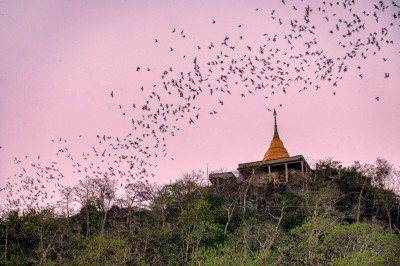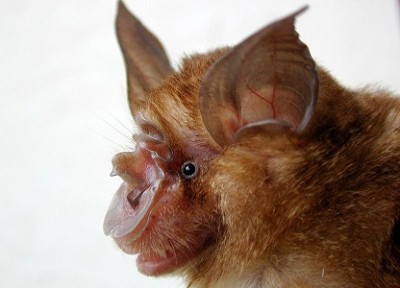NEWS
16 November 2022
Why do bat viruses keep infecting people?
Landmark study reveals ‘spillover’ mechanism for the rare but deadly Hendra virus.
Australian flying foxes host a virus called Hendra, which has spilled over into people and can cause a rare but deadly respiratory infection.Credit: Auscape/Universal Images Group/Getty
“Hey guys, could you open your wings and show me?” says Peggy Eby, looking up at a roost of flying foxes in Sydney’s Botanical Gardens. “I talk to them a lot.”
Eby, a wildlife ecologist at the University of New South Wales in Sydney, Australia, is looking for lactating females and their newborn pups, but the overcast weather is keeping them snuggled under their mothers’ wings. Eby has been studying flying foxes, a type of bat, for some 25 years. Using her binoculars, she tallies the number of lactating females that are close to weaning their young — a proxy for whether the bats are experiencing nutritional stress and so probably more likely to shed viruses that can make people ill.

Tens of thousands of people exposed to bat coronaviruses each year
Australian flying foxes are of interest because they host a virus called Hendra, which causes a very rare but deadly respiratory infection that kills one in every two infected people. Hendra virus, like Nipah, SARS-CoV and SARS-CoV-2 (the virus that caused the COVID-19 pandemic) is a bat virus that has spilled over into people. These viruses often reach humans through an intermediate animal, sometimes with deadly consequences. Scientists know that spillovers are associated with habitat loss, but have struggled to pinpoint the specific conditions that spark events until now.
After a detailed investigation, Eby and her colleagues can now predict — up to two years ahead — when clusters of Hendra virus spillovers will probably appear. “They have identified the environmental drivers of spillover,” says Emily Gurley, an infectious-diseases epidemiologist at Johns Hopkins University in Baltimore, Maryland. And they have determined how those events could be prevented. The results are published in Nature on 16 November1.
Food stress
Specifically, the researchers found that clusters of Hendra virus spillovers occur following years in which the bats experience food stress. And these food shortages typically follow years with a strong El Niño, a climatic phenomenon in the tropical Pacific Ocean that is often associated with drought along eastern Australia. But if the trees the bats rely on for food during the winter have a large flowering event the year after there’s been a food shortage, there are no spillovers. Unfortunately, the problem is that “there’s hardly any winter habitat left”, says Raina Plowright, a disease ecologist and study co-author at Cornell University in Ithaca, New York.
The study is “absolutely fantastic”, says Sarah Cleaveland, a veterinarian and infectious-disease ecologist at the University of Glasgow, UK. “What’s so exciting about it is that it has led directly to solutions.” Cleaveland says the study’s approach of looking at the impact of climate, environment, nutritional stress and bat ecology together could bring new insights to the study of other pathogens, including Nipah and Ebola, and their viral families. The study provides “a much clearer understanding of drivers of this issue, with broad relevance to pandemics elsewhere”, says Alice Hughes, a conservation biologist at the University of Hong Kong. “The paper underscores the enhanced risk we are likely to see” with climate change and increasing habitat loss, she says.
Urban shift
Hendra virus was identified in 1994, following an outbreak in horses and people at a thoroughbred training facility in Brisbane, Australia. Studies later established that the virus spreads from its bat reservoir — most likely the black flying fox (Pteropus alecto) — to horses through faeces, urine and spats of chewed-up pulp the flying foxes spit out on the grass. Infected horses then spread the virus to people. Infections typically occur in clusters during the Australian winter, and several years can go by before another cluster emerges in horses, but cases have been picking up since the early 2000s.

Bat cave solves mystery of deadly SARS virus — and suggests new outbreak could occur
To study the mechanism of spillovers, Plowright, Eby and their colleagues collected data on the location and timing of such events, the location of bat roosts and their health, climate, nectar shortages and habitat loss over some 300,000-square kilometres in southeast Australia from 1996 to 2020. Then they used modelling to determine which factors were associated with spillovers. “I’m just in awe of the invaluable data sets that they have on the ecology,” says Gurley.
Over the course of the study, the team noticed significant changes in the bats’ behaviour. The flying foxes went from having predominantly nomadic lifestyles — moving in large groups from one native forest to the other in search of nectar — to settling in small groups in urban and agricultural areas, bringing the bats closer to where horses and people live. The number of occupied bat roosts in general has trebled since the early 2000s to around 320 in 2020.
A separate study from the team2 found that the newly established roosts shed Hendra virus every winter, but in years following a food shortage bats shed more virus. There were “really dramatic winter spikes in infection”, says co-author Daniel Becker, an ecologist who focuses on infectious diseases at the University of Oklahoma in Norman. The study also linked increased viral shedding in bats to increased spillovers to horses.
In search of nectar
Modelling in Plowright and Eby’s most recent Nature paper shows that flying-fox populations split into small groups that migrated to agricultural areas close to horses when food was scarce, and that food shortages followed strong El Niño events, probably because native eucalyptus tree budding is sensitive to climate changes. To conserve energy, the bats fly only small distances in these years, scavenging for food in agricultural areas near horses. Spillovers to horses were most likely to occur in winters following a food shortage, says Plowright. Their model was able to accurately predict in which years these would occur.
Then something unexpected happened. An El Niño occurred in 2018 followed by a drought in 2019, suggesting that 2020 should also have been a spillover year. But there was only one event in May and none has been detected since. “We threw all the cards back up into the air and looked carefully at all the other elements of our hypothesis,” says Eby. Eventually they discovered that when native forests have major flowering events in winters following a food shortage, this helps to avert spillovers. In 2020, a red-gum forest near the town of Gympie flowered, drawing in some 240,000 bats. And similar winter flowering events occurred in other regions in 2021 and 2022.
The researchers suggest that these mass migrations take the bats away from horses. They propose that by restoring the habitats of those handful of species that flower in winter, fewer spillovers in horses, and potentially in people, would occur. And by restoring the habitats of other animals that host dangerous pathogens, “maybe we can prevent the next pandemic”, says Plowright.
doi: https://doi.org/10.1038/d41586-022-03682-9
References
Eby, P. et al. Nature https://doi.org/10.1038/s41586-022-05506-2 (2022).
Becker, D. J., Eby, P., Madden, W., Peel, A. J. & Plowright, R. K. Ecol. Lett. https://doi.org/10.1111/ele.14007 (2022).